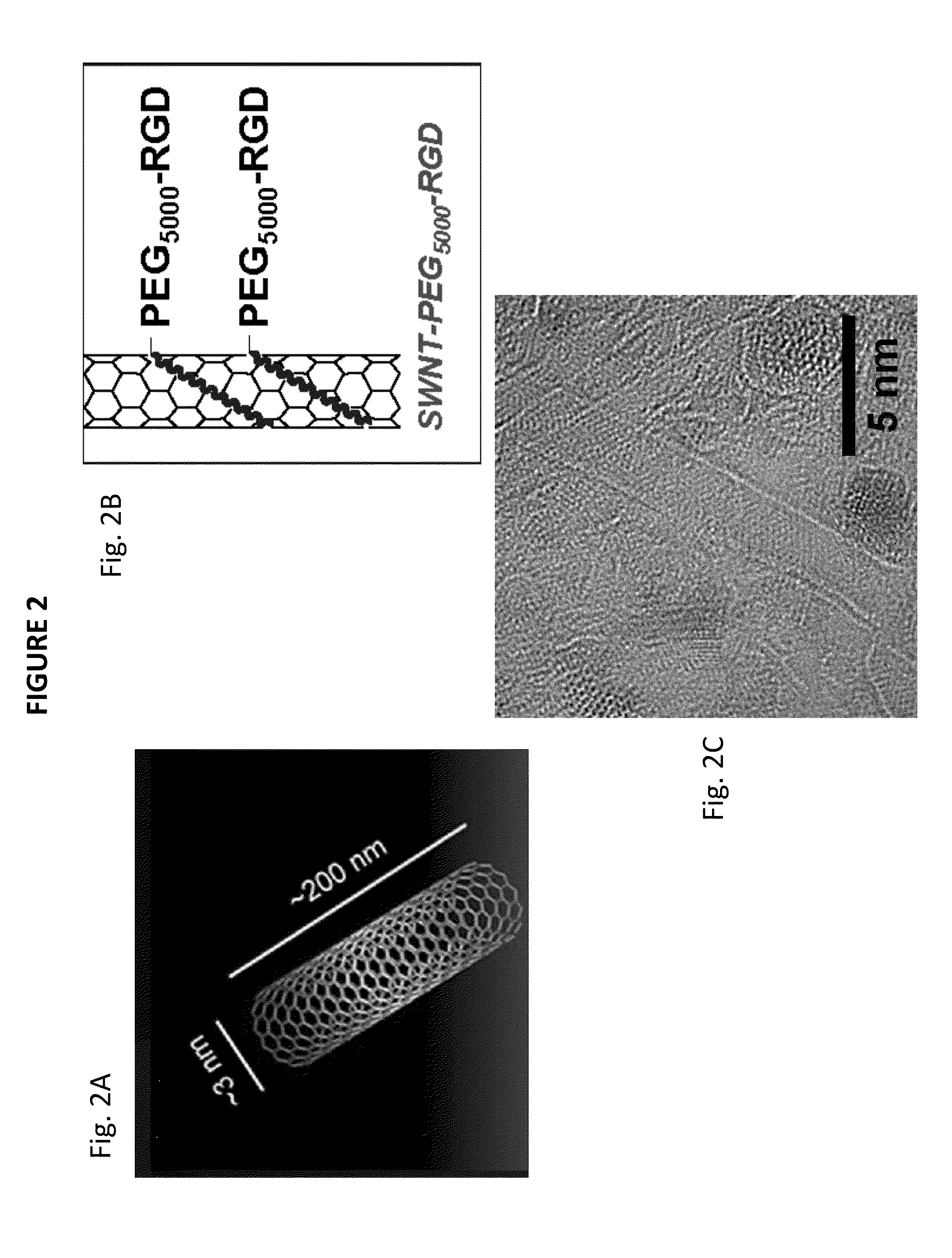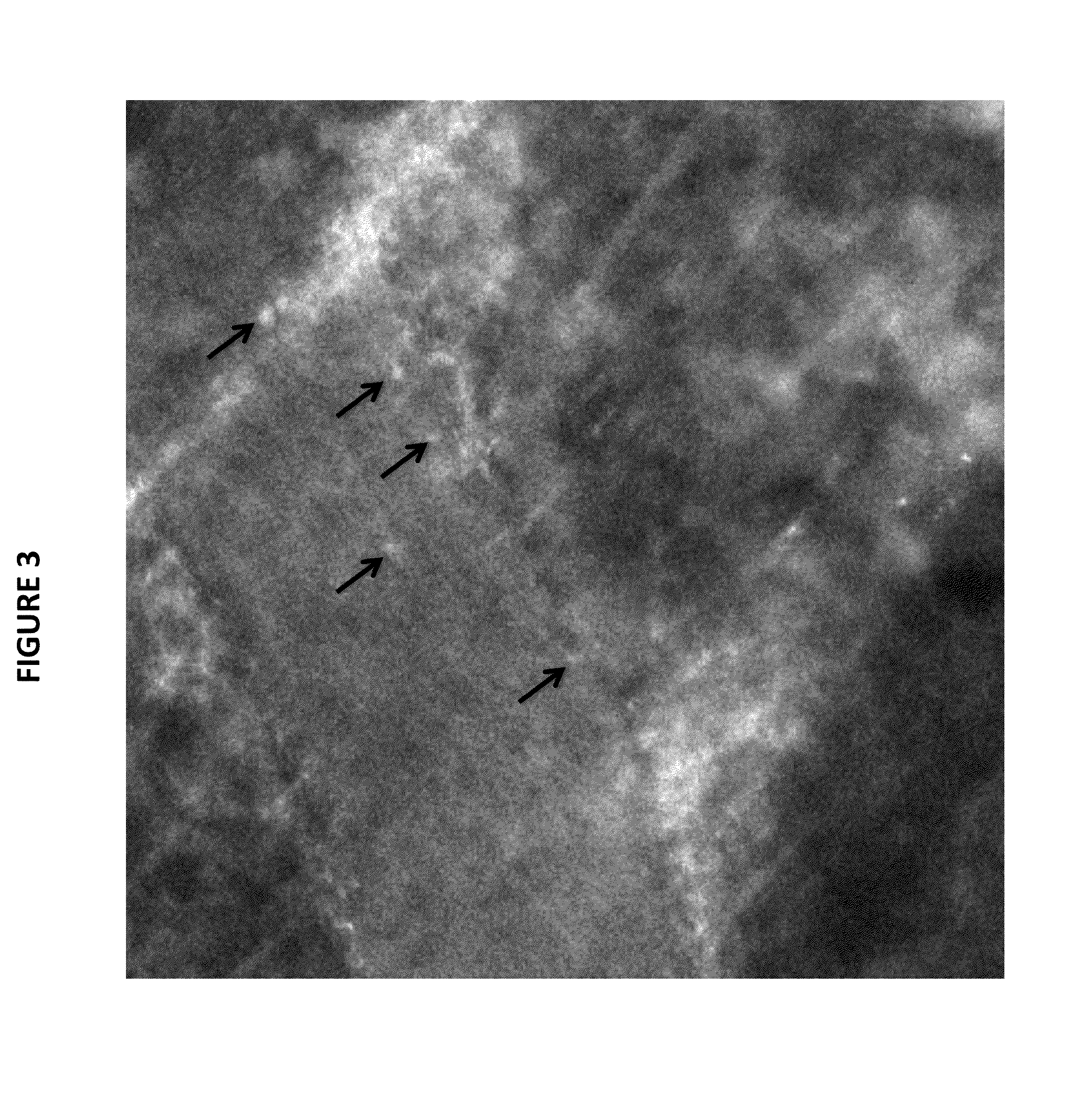Carbon nanotubes for imaging and drug delivery
a technology of carbon nanotubes and drug delivery, which is applied in the field of imaging and drug delivery, can solve the problems of false positives as well as false negatives, difficult to specifically locate, and unnecessary invasive tests on a human subject, and achieve the effect of effective human use and delivery of carbon nanotubes
- Summary
- Abstract
- Description
- Claims
- Application Information
AI Technical Summary
Benefits of technology
Problems solved by technology
Method used
Image
Examples
example 1
Visualization of the Movement of Single-Walled Carbon Nanotubes (SWNTs)
[0089]This example shows the injection of various forms of nanotubes into the body of a mouse that has at least one tumor. Movement of the nanotubes is followed by the use of fluorescent dyes as visualized through intravital microscopy.
[0090]To observe nanotube targeting, fluorescence microscopy was used. This consists of the instrument shown in FIGS. 1a and 1b, with the lens juxtaposed to the mouse's body. The microscope employs four input lasers and three simultaneous output channels to dynamically image a tumor in living subjects. FIG. 1c shows the dorsal skinfold chamber which is surgically implanted into the mice; the device allows stabilization of mouse motion and provides a transparent window for optical microscopy.
[0091]FIG. 2 shows nanotubes in a variety of forms. FIG. 2a shows the netting-type shape of the nanotubes used which have dimensions that range from approximately 3 nm to about 200 nm. FIG. 2b i...
example 2
SWNTs Functionalized with Peptides
[0092]For initial intravital microscopy, mice were injected into the tail with approximately 5×105 EGFP-transfected U87MG tumor cells and the tumor was allowed to grow for about 10-14 days. EGFP is enhanced green fluorescent protein, first isolated from jellyfish, and then modified to enhance the green fluorescence. Cy5.5 was used to show the nanotubes, and a long-term dye was used to show the circulating blood.
[0093]For intravital microscopy of the SWNTs, 18 mice were injected with various experimental and control nanotubes: SWNTs with conjugated RGD, SWNTs with conjugated RAD, and plain SWNTs without attached peptides, as well as BSA without any SWNTs and other controls. SWNT behavior was visualized from injection into the mouse until about 4 hours post-injection, and then at designated time-points throughout the first day and first week post-injection. At each time point, 5-20 fields-of-view in the tumor were acquired to create a time series. Mor...
example 3
Peptide Dependency of the SWNT Uptake
[0096]FIG. 4 illustrates the uptake of SWNTs and shows that uptake is peptide dependent. Three types of nanotubes were compared: plain, i.e. non-conjugated, SWNTs; RGD-conjugated SWNTs, and RAD-conjugated SWNTs. Cells per minute per field of view were counted within 10 minutes of injection. As seen in FIG. 4, uptake of the SWNTs is clearly a function of peptide presence (p<0.001). While the plain SWNTs were taken up into circulating cells almost immediately after injection, uptake of RGD- or RAD-conjugated SWNTs into circulating cells was much slower. The kinetics of interaction between cells containing RGD- or RAD-SWNTs and the vasculature is shown by the amount of cells per minute. Clearly, plain SWNTs are taken up by circulating cells much faster than are RGD- or RAD-conjugated SWNTs. The same type of information is shown in FIG. 5, where in vitro experiments verified the peptide dependence of uptake of SWNTs into RAW cells. At even 10× lower ...
PUM
| Property | Measurement | Unit |
|---|---|---|
| time | aaaaa | aaaaa |
| molecular weight | aaaaa | aaaaa |
| diameter | aaaaa | aaaaa |
Abstract
Description
Claims
Application Information
 Login to View More
Login to View More - R&D
- Intellectual Property
- Life Sciences
- Materials
- Tech Scout
- Unparalleled Data Quality
- Higher Quality Content
- 60% Fewer Hallucinations
Browse by: Latest US Patents, China's latest patents, Technical Efficacy Thesaurus, Application Domain, Technology Topic, Popular Technical Reports.
© 2025 PatSnap. All rights reserved.Legal|Privacy policy|Modern Slavery Act Transparency Statement|Sitemap|About US| Contact US: help@patsnap.com



